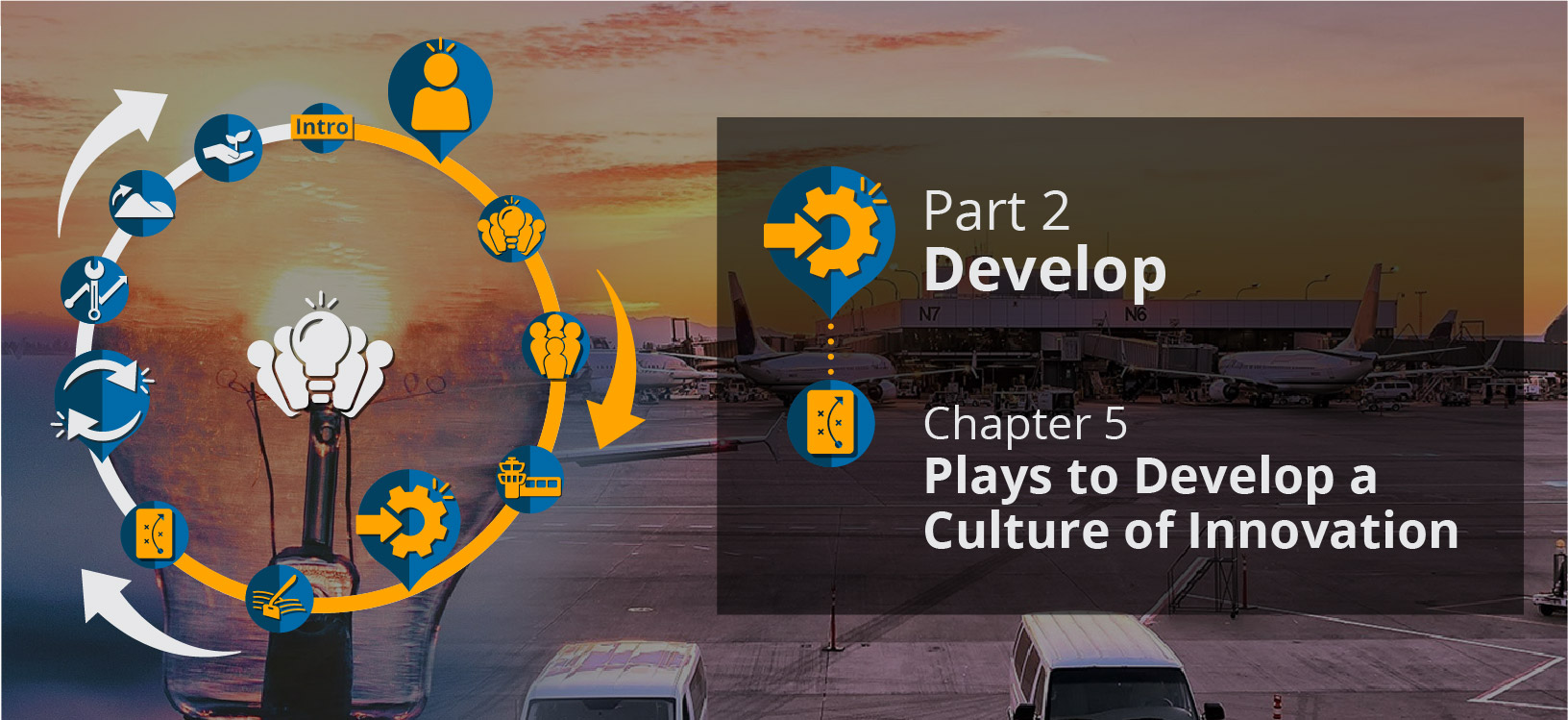

This is a Deep Dive page. Select the chapter for the Fast Track
Play 16: Aligning Organizational Structure to Support Innovation (Organizational)
No two airports operate the same way, even if they have the same type of business structure on paper. One differentiator is the type of governance structure they have. Some airports are operated by a port authority arrangement or government branch, or they might act as an airport authority; others are one of many municipal or county departments subject to the policies of that governing body. Another differentiator to consider is airport size (large, medium, small, or non-hub) and organizational structure; some are more hierarchical in nature, while others offer a flatter and possibly more organic structure. Any number of combinations of governance and structures may exist, therefore no single solution will support innovation in each type of airport structure.
Gauging the Success of Your Organizational Structure
Innovative leaders
- Remove dysfunction for innovation functionality. Seek to understand why the airport functions the way it does. Current culture can often be traced back to the structures that influenced it. This information can inform future strategies for driving innovation into the culture. Consider how long this structure has been in place and whether the structure meets the needs of the organization and, more importantly, its customers. Conduct an analysis of the organizational structure and compare it with other entities to see how best to cultivate a culture of innovation.
- Assess pros and cons of each organizational structure. Airports are usually organized into departments that are aligned by business function (planning, engineering, operations, etc.). The larger the airport, the more people are involved and, typically, the more hierarchical the structure due to the vast size and span of control for the organization. This can be further complicated if an airport's governance structure is part of a city/county arrangement because the airport is then just one department or division of an even larger municipal entity.
- Understand the hierarchical structure. Know the positive attributes associated with the hierarchical structure, such as clear lines of communication through the rank and file, which enables employees to definitively know their roles and responsibilities. However, these vertical organizations often face siloed thinking, which can be challenging when trying to encourage coordination and collaboration between other business functions. These organizations are typically more resistant to change, and communication needs to be very strong and effective to make inroads in innovation.
- Understand the organic structure. An organic structure eliminates many of the management layers often seen in hierarchical structures. This flatter structure can improve communication and coordination among employees, and it can provide opportunities for each staff member to have more autonomy and responsibilities. This structure can also reduce bureaucracy by streamlining the decision-making process. However, flatter organizations do not offer as many job advancement opportunities, which could impact employee motivation. Be sure to assess the pros and cons of the organizational structure within the context of the governance structure and the benefits seen by customers.
Cultivate Innovation in Your Culture
Most organizations with an innovative culture find that creating connections among employees is vital. Innovative leaders recognize the need to have an organizational structure that creates a place where people feel valuable and valued. To quote Patrick Lencioni, author of The Five Dysfunctions of a Team, ”Organizational health is the single greatest competitive advantage in any business."1
Innovative leaders
- Innovate the organizational structure. Consider changing from a rigid, hierarchical structure to a flatter, more organic structure to help foster a setting that is more open and collaborative, and thus more innovative. In addition, consider aligning business functional units with divisional elements to focus more adeptly on customer needs, and thus create a culture with a focus on innovation.
- Form teams to synergize innovation. When major structural changes are not an option, consider augmenting a structure that utilizes the business function units of the hierarchical system and incorporates cross-functional teams. Creating cross-organizational teams or a dedicated culture of innovation team (as discussed in Try Innovation in Chapter 4) can break down boundaries and encourage communication among different units. Airports that innovate throughout the entire organization are the most successful at creating a lasting culture of innovation. For instance, airports that form innovation committees or teams involving department heads from across the airport enterprise get the most buy-in and a strong foothold in making innovation a part of their culture. These cultures ensure that staff meetings and performance reviews all involve discussions around innovation goals and processes. In addition, team-building activities can be used to discuss innovation goals and processes, reinforcing their importance.
- Ensure teams function well. Teams are great at creating collaborative opportunities for employees across an organization, but they need to be set up effectively to work well. Make sure they enforce clear lines of communication among team members so that it is easy to get feedback from staff from various departments, as needed. Form teams that are not too large to ensure that necessary work gets done. If set up well, teams can provide a path for idea generation, evaluation, and feedback, and they can give leaders the ability to provide incentives and rewards for teams to create new ideas together, reinforcing innovation. Also, identify the right people to lead these teams. It can be helpful to use an organizational chart to identify innovators to lead these teams, as stated in Cultivation Cycle in Chapter 4.

1 Patrick Lencioni, The Five Dysfunctions of a Team: A Leadership Fable (San Francisco, CA), 2002, https://www.tablegroup.com/product/dysfunctions/.

